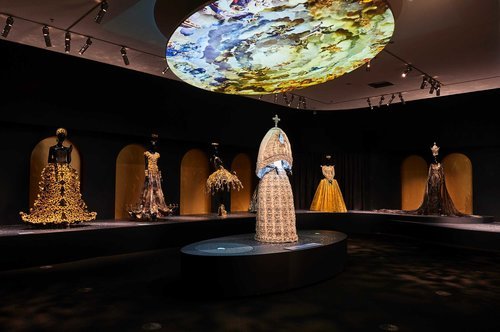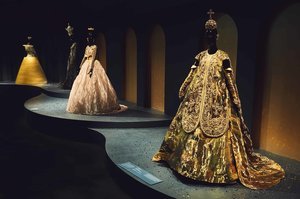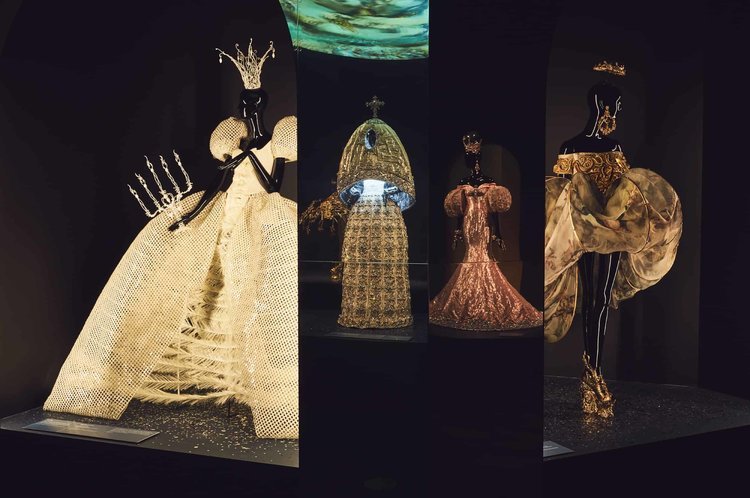Chapter 1: Guo Pei NGV Triennial




“When presented with such manifold opulence, the most natural reactions are humility and awe. Standing in the presence of these creations shakes the soul from its mooring, like looking upon Jan Hubert Van Eyck’s Ghent Altarpiece or Raphael’s The School of Athens for the first time. The mind reels.” — Paula Wallace, Guo Pei: Beyond Couture (New York, NY: Rizzoli Electa, 2017).
In the quotation copied above, Paula Wallace’s intention in comparing the work of Chinese fashion designer Guo Pei to canonical visual artists such as Van Eyck and Raphael is to lend Pei’s designs the aura of a masterpiece.[1] If, as Wallace suggests, fashion and art provide similar aesthetic experiences, then do haute couture designs like Pei’s belong in the same categories and spaces as ‘high art’? Art and fashion have both had a long history of adapting and reacting to culture. Recently, clothing is increasingly exhibited in the space of the museum as an example of the highest level of cultural product.[2] To understand the complex relationship between the way art and clothing have been received in the spaces of ‘high art’, it is better to compare how art and fashion cross over and interact with another rather than comparing their traditional status. This chapter will explore how even though we can experience the cultural forms similarly, they do not belong in the same category. A significant problem arises if we place fashion into the already existing traditional category of ‘art.’ This is because it is difficult define what art actually is as it can change depending on the culture, society or space. Although art and fashion have often looked to one another for inspiration, fashion has often been considered of a lower status because it is seen as being less complex and easier to understand.[3] However, this is not a universal belief or historical truth, as Wallace’s response Guo Pei reveals.
Guo Pei’s Legends Collection was on display as a part of the Triennial at the National Gallery of Victoria, Australia in 2017. The inclusion of the work of a fashion designer in a Triennial that usually features work made by individuals who self-identify as ‘artists’, emphasises that the experience and spectacle that is created by the display of fashion is effective in engaging an audience. Fashion designs have the unique ability to connect with an audience because of their familiarity and the way in which we interact with them on an everyday basis manifesting the “lived experience.”[4] In the contemporary world, we interact with and are surrounded by clothing and images of clothing to the point of saturation.[5] Although a general audience may not be familiar with the complex design principles of haute couture (because we do not interact with it in our daily lives), we are familiar with basic fashion design principles, such as the ability of the shape of a dress to participate in social and cultural discourses.[6] What happens when clothing moves from the sphere of the real world to the museum – to being worn on bodies to being displayed behind vitrines? Couture’s functionality significantly changes the moment it is placed on a mannequin in the museum.[7]
Works in the 2017/18 Triennale were displayed in spaces across the National Gallery of Victoria. The exhibition drew works from over one hundred artists and designers to provide a survey of “art and design, across cultures…and perspectives.”[8] Most works were placed on white walls in rooms that flowed on from one another. The room which held Pei’s designs was entered through one door and exited from another on the other side of the room. The room strongly contrasted the light filled space that the audience emerged from, transporting them into the world of Pei’s couture designs.
The designs, based on the Cathedral of Saint Gallen in Switzerland, were from Pei’s Spring/Summer 2017 Legends Collection. Taking over two years to complete, Pei experienced such awe when visiting the cathedral that she missed her flight to spend hours admiring the Cathedral’s interior. To connect with this experience, projections of the cathedral’s interior were displayed throughout the room, and on raised platforms with speckles of gold surrounding the base of the garment, further enhanced with dramatic lighting. Each garment has been woven with a variety of unusual materials such as metal fibre and silk thread, which weighed approximately 890 grams per metre.[9] These are expensive materials that you expect to find on complex artworks. Furthermore, the fabrics were created from the original archival drawings of the dome which are stored in the Abbey.[10] In other words, the couture designs become an adaptation of these drawings and transport the viewer to the cathedrals atmosphere.[11] The fashion curator of the Pei’s installation, Paola Di Trocchio, describes the collection being instilled with “great mythological stories and exceptional art” that propose a narrative of power for history and the church.[12] Much like the Cathedral, Pei’s works from her Legends Collection have the ability to create spectacle and awe amongst its audience because it removes the viewer from ordinary life into the “sublime” through its use of rich materials.[13]
These extravagant materials have ensured that Guo Pei, a Chinese designer, has become well-known for her elaborate creations. This is because of their ability to create spectacle and inspire awe amongst the designer’s audience, who consider her designs as art.[14] Pei was admitted as a guest member to the Chambre Syndicale de la Haute Couture, the world’s most authoritative body on haute couture design. At the same time, Pei’s first solo exhibition occurred at the Musée des Arts Décoratifs in Paris.[15] Ever since this significant exhibition, her works have regularly been displayed in museums.[16]
Pei believes that her work’s rightful place is within a museum as she says:
“The beauty of haute couture is everlasting and unfading, marked by the memories of past stories and splendours that glitter through time…I hope my haute couture pieces can become collectable, crown jewels and masterpieces that last.”[17]
Like many works of art, most of Pei’s designs are not primarily functional. They are not designed to be worn. It makes perfect sense than for her work to be admired in the museum space.
As one of the head-liners of the Trienniale, her works, attracted fashion and non-fashion audiences.[18] It could be suggested that the rising popularity of fashion exhibitions is due to the universal aesthetic experience that is undertaken when viewing designs which cause the viewer to wonder at how the fashion object was made.[19] There is an increased likelihood an audience will understand the fundamental design principles and be able to identify garments such as a dress. However, access to haute couture is usually restricted by the fashion industry, and not accessible to a daily audience. In a museum context, with the knowledge of the fundamental design, the audience experience the works with a sense of awe and admiration because they are able to imagine that these garments were once worn. It is not just a simple fashion design but instead the viewer experiences the intricate materials and details which push beyond the audience’s imagination of what clothes can be. This awe-inspiring experience could be likened to the way we experience our favourite artworks which makes us ask ‘how has a designer imagined and created this?’
A fine example of this awe-inspiring experience is Guo Pei’s White Goddess Dress (metallic fabric, silk, embroidery, crystals) which was presented at the centre of the exhibition (see figure 1.1). Without this controlled curatorial environment, the work cannot be viewed or appreciated in the same way. The museum atmosphere created through projections from the church that the dress is directly inspired from means that it can be experienced in its entirety. This can be likened to the way a traditional artwork may have multiple layers which is only revealed by understanding the context behind the work and once these details have been revealed the viewer has a deeper experience.[20]
Clearly reminiscent of the dome of St Gallen Cathedral, the dress consists of a golden heavily embroidered floor length skirt, wrist cuffs, a bodice and colossal dome-shaped headpiece, which is topped with a cross. The beautiful and expensive fabric represents the illuminating materials of the cathedral. The black mannequin displayed against black walls, platforms and floor ensured that the garment was viewed as a work of art rather than a worn garment. This is because there are no outside distractions to capture the audience’s attention and the blackness blurs into the background. It makes sense that this garment was displayed in the middle of the room as the starting point of the entire collection. The dress informs the rest of the garments on display because it immediately transports the viewer back to the Cathedral (see figures 1.2-1.3).[21] This focus was emphasised by the stark contrast between dark black and the silver dress. The light inside the headpiece created an ephemeral glow to the work. One cannot help being drawn into the light that radiated from the headdress, which imitates the grand dome.
If you would like to read more of this chapter please contact me.
[1] Paula Wallace is the president and co-founder of the Savannah College of Art and Design; Valerie Steele “Fashion,” In Fashion and Art, 13.
[2] Steele, “Museum Quality,” 8.
[3] Entwistle, The Fashioned Body,18; Vänskä and Clark, “Introduction: Fashion Curating in the museum and Beyond,” In Fashion Curating, 2.
[4] Greer Crawley and Donatella Barbieri “Dress, Time and Space: Expanding the Field through exhibition Making” In The Handbook of Fashion Studies, edited by Sandy Black (London: Bloomsbury Publishing, 2014), 75.
[5] Gilles Lipovetsky, The Empire of Fashion: Dressing Modern Democracy, trans. Catherine Porter (Princeton, NJ: Princeton University Press, 1994), 10.
[6] Entwistle, The Fashioned Body, 39.
[7] Oakley Smith and Kubler, “Eye Candy and Ideas: Fashion as Exhibition” In Art/fashion in the 21st Century, 158.
[8] “Triennial,” National Gallery of Victoria, accessed May 1, 2019. https://www.ngv.vic.gov.au/exhibition/ngv-triennial/
[9] Oakley Smith and Kubler, “Fashion as Art” In Art/fashion in the 21st Century, 27; Paola Di Trocchio, “Guo Pei” NGV Magazine 8, Jan/Feb (2018): 87.
[10] Di Trocchio, “Guo Pei,” 87; Amy Verner, “Spring 2017 Couture Guo Pei” Vogue, January 26, 2017, https://www.vogue.com/fashion-shows/spring-2017-couture/guo-pei
[11] “Interview: Couturier Guo Pei's Art of Fashion” Design Art Magazine, May 28, 2019 http://www.designartmagazine.com/2019/05/interview-couturier-guo-pei.html
[12] Di Trocchio, “Guo Pei,” 88.
[13] Lynn Yaeger, “Made in China” In Guo Pei, 9.
[14] “Guo Pei” Savannah College of Art and Design, accessed May 21, 2019, https://www.scad.edu/guo-pei
[15] “NGV TRIENNIAL: Artwork Labels,” National Gallery of Victoria, accessed May 23, 2019, 132. https://www.ngv.vic.gov.au/wp-content/uploads/2017/02/NGV-TRIENNIAL-Large-Print-Labels_v4.pdf
[16] For instance, her designs were debuted in the U.S at the SCAD FASH Museum in Atlanta which travelled around America. - “Guo Pei,” SCAD.
[17] Paola Di Trocchi “Interview with Guo Pei” in NGV Triennial 2017, edited by Mark Gomes (Melbourne: National Gallery of Victoria, 2017), 530.
[18] Geczy and Karaminas, “Fashion and Art: Critical Crossovers,” In Fashion and Art, 10; Oakley Smith and Kubler “Fashion as Art,” 150; Patty Huntington, “Guo Pei Among Headliners at the NGV Triennial in Melbourne” WWD, December 14, 2017. https://wwd.com/fashion-news/designer-luxury/guo-pei-among-headliners-at-the-ngv-triennial-in-melbourne-11074670/
[19] Crawley and Barbieri, “Dress, Time and Space,” 73.
[20] Oakley Smith and Kubler “Eye candy and ideas,” 154; Vänskä, “Boutique – Where Art and Fashion Meet: Curating as Collaboration and Cultural Critique,” In Fashion Curating, 131; Alexander Palmer, “Looking at Fashion: The Material Object as Subject,” In The Handbook of Fashion Studies, 269.
[21] “NGV TRIENNIAL: Artwork Labels,” National Gallery of Victoria, 154.
© Amelia Elsmore, 2019. Unauthorised use and/or duplication of this material without express and written permission from this site’s author and/or owner is strictly prohibited. Excerpts and links may be used, provided that full and clear credit is given to Amelia Elsmore and ameliaelsmore.com with appropriate and specific direction to the original content.